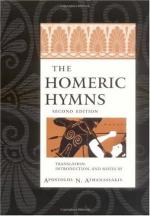According to a highly ingenious, but scarcely persuasive theory of Mr. Verrall’s, this interest is unfriendly. {13} Our second part is no hymn at all, but a sequel tacked on for political purposes only: and valuable for these purposes because so tacked on.
From line 207 to the end we have this sequel, the story of Apollo’s dealings as Delphinian, and as Pythian; all this following on detached fragments of enigmatic character, and containing also (305-355) the intercalated myth about the birth of Typhaon from Hera’s anger. In the politically inspired sequel there is, according to Mr. Verrall, no living zeal for the honour of Pytho (Delphi). The threat of the God to his Cretan ministers,—“Beware of arrogance, or . . . “—must be a prophecy after the event. Now such an event occurred, early in the sixth century, when the Crisaeans were supplanted by the people of the town that had grown up round the Oracle at Delphi. In them, and in the Oracle under their management, the poet shows no interest (Mr. Verrall thinks), none in the many mystic peculiarities of the shrine. It is quite in contradiction with Delphian tradition to represent, as the Hymn does, Trophonius and Agamedes as the original builders.
Many other points are noted—such as the derivation of “Pytho” from a word meaning rot,—to show that the hymnist was rather disparaging than celebrating the Delphian sanctuary. Taking the Hymn as a whole, more is done for Delos in three lines, says Mr. Verrall, than for Pytho or Delphi in three hundred. As a whole, the spirit of the piece is much more Delian (Ionian) than Delphic. So Mr. Verrall regards the Cento as “a religious pasquinade against the sanctuary on Parnassus,” a pasquinade emanating from Athens, under the Pisistratidae, who, being Ionian leaders, had a grudge against “the Dorian Delphi,” “a comparatively modern, unlucky, and from the first unsatisfactory” institution. Athenians are interested in the “far-seen” altar of the seaman’s Dolphin God on the shore, rather than in his inland Pythian habitation.
All this, with much more, is decidedly ingenious. If accepted it might lead the way to a general attack on the epics, as tendenz pieces, works with a political purpose, or doctored for a political purpose. But how are we to understand the uses of the pasquinade Hymn? Was it published, so to speak, to amuse and aid the Pisistratidae? Does such remote antiquity show us any examples of such handling of sacred things in poetry? Might we not argue that Apollo’s threat to the Crisaeans was meant by the poet as a friendly warning, and is prior to the fall of Crisa? One is reminded of the futile ingenuity with which German critics, following their favourite method, have analysed the fatal Casket Letters of Mary Stuart into letters to her husband, Darnley; or to Murray; or by Darnley to Mary, with scraps of her diary, and false interpolations. The enemies of the Queen, coming into possession of her papers after the affair of Carberry Hill, falsified the Casket Letters into their present appearance of unity. Of course historical facts make this ingenuity unavailing. We regret the circumstance in the interest of the Queen’s reputation, but welcome these illustrative examples of what can be done in Germany. {16a}




